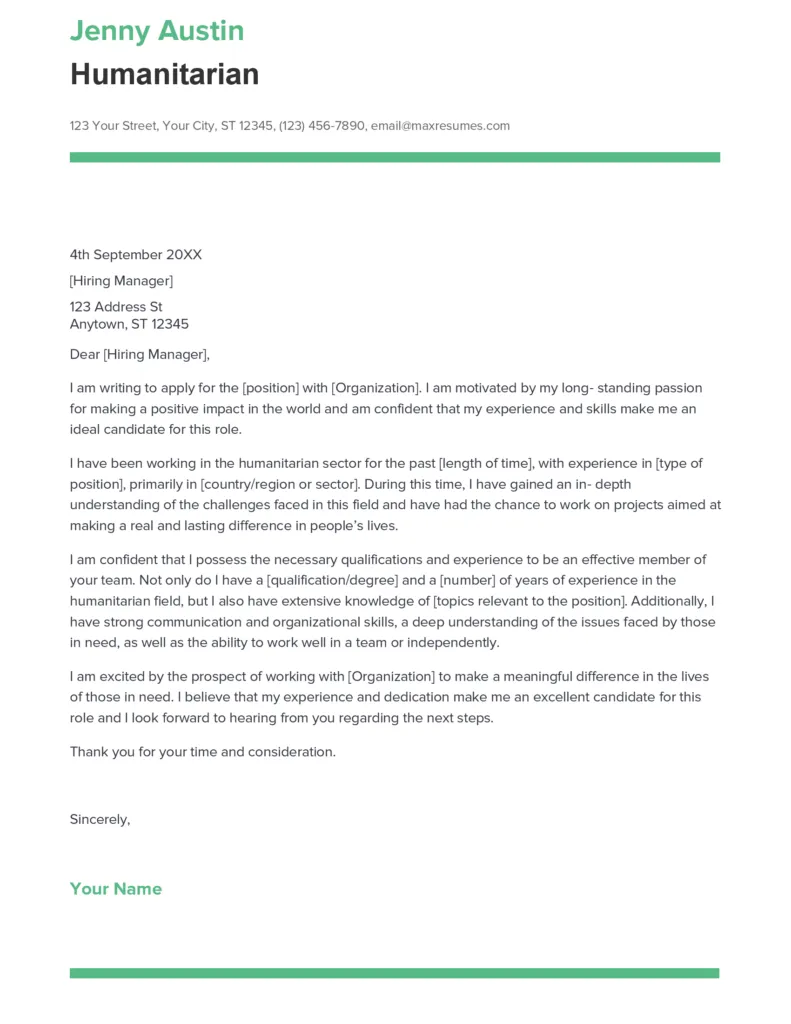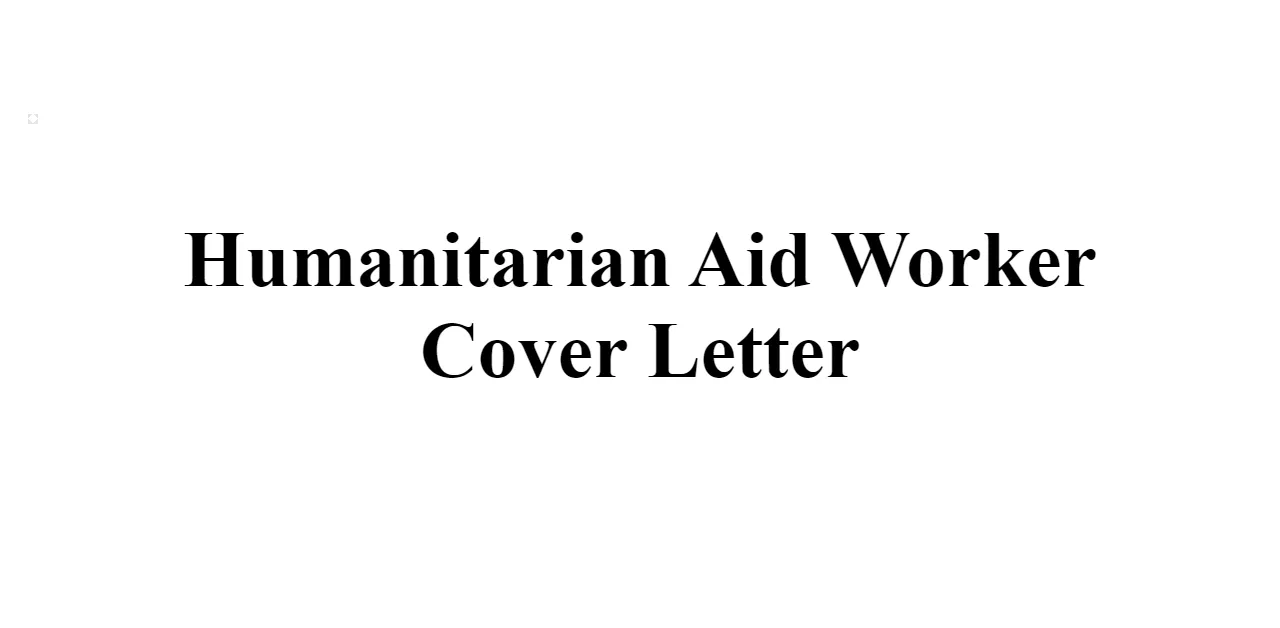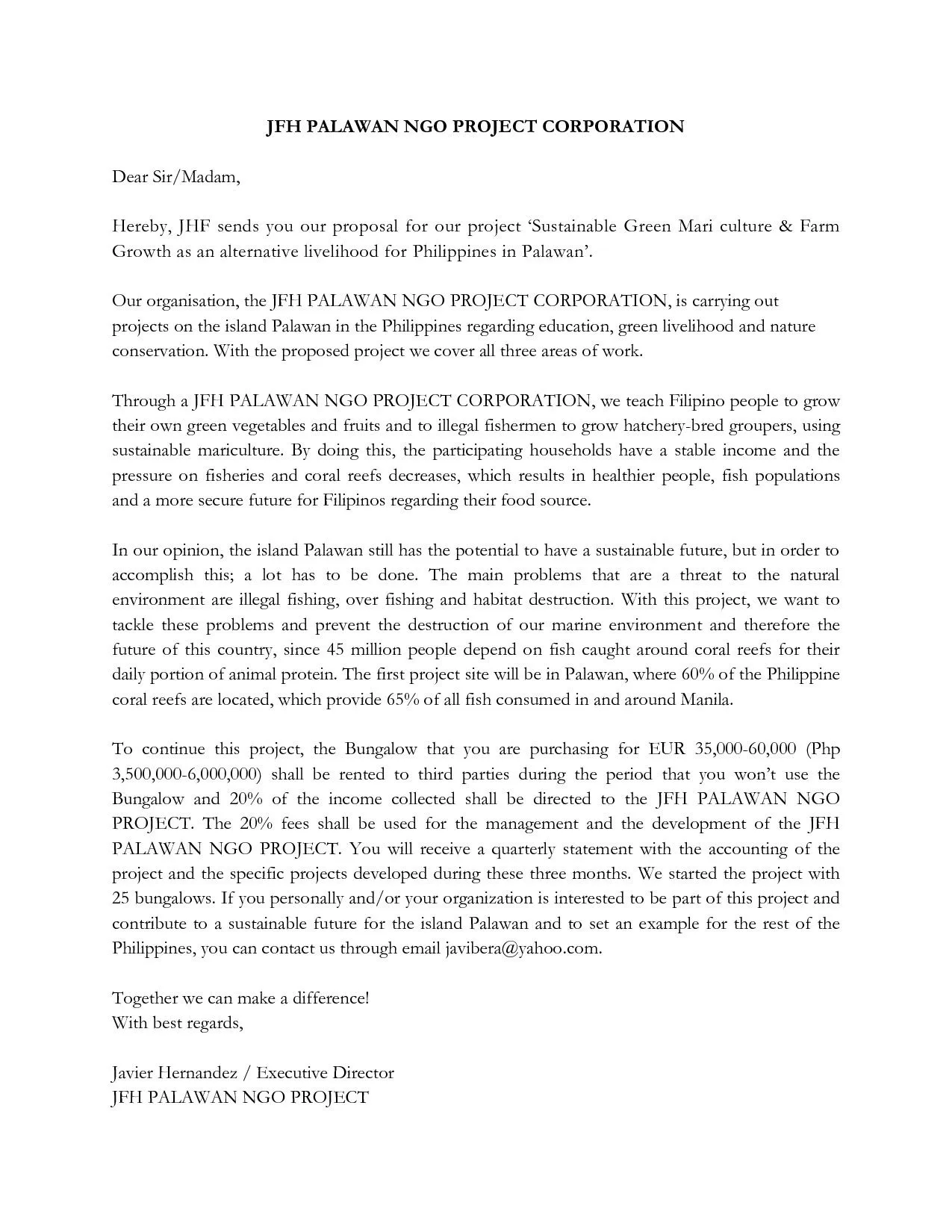Understanding the Humanitarian Job Landscape
The humanitarian sector is a dynamic and competitive field, characterized by a diverse range of organizations, from large international NGOs to smaller, local initiatives. Understanding this landscape is the first step in crafting an effective cover letter. Research the specific organizations you’re applying to. Familiarize yourself with their mission, values, and the types of projects they undertake. This knowledge allows you to tailor your cover letter to demonstrate your genuine interest and relevant experience. The humanitarian sector is also incredibly diverse, with roles spanning various fields, including project management, logistics, finance, health, education, and advocacy. Knowing the specific requirements of the role you’re applying for is paramount to highlight your relevant skills and experience and to make sure your cover letter is aligned with the role requirements. Successful applicants show not only understanding of the humanitarian landscape but also adaptability and a willingness to learn. They are able to demonstrate their grasp of humanitarian principles like neutrality, impartiality, independence, and humanity.
Key Elements of a Strong Humanitarian Cover Letter
A compelling humanitarian cover letter goes beyond a simple recitation of your resume. It’s a narrative that connects your skills, experiences, and passion with the specific requirements of the job and the values of the organization. Start with a strong opening, clearly stating the position you’re applying for and where you found the job listing. Briefly, highlight your key qualifications and express your enthusiasm for the opportunity. The body of your cover letter should focus on demonstrating how your skills and experience align with the job description. Use specific examples to showcase your accomplishments and quantify your results whenever possible. The most important element of all is to ensure that you demonstrate a clear understanding of humanitarian principles, and incorporate these in the cover letter. Conclude with a concise and confident closing, reiterating your interest, summarizing your key strengths, and expressing your availability for an interview. Always include a call to action, such as ‘I look forward to the opportunity to discuss my application further’.
Highlighting Your Skills and Experience

Humanitarian organizations seek candidates with a diverse set of skills. In your cover letter, clearly articulate the skills you possess and how they relate to the job requirements. These skills often include project management, cross-cultural communication, problem-solving, and the ability to work under pressure. Detail your experience and provide specific examples of how you have successfully utilized these skills in the past. If the job description emphasizes the need for experience in a particular area, such as emergency response or program implementation, ensure that your cover letter prominently features relevant examples. Quantify your achievements whenever possible, such as by mentioning the number of people you’ve assisted, the budget you’ve managed, or the efficiency improvements you’ve implemented. Humanitarian organizations prioritize candidates who not only have the necessary skills but also a proven track record of success. This is often critical in these challenging environments.
Tailoring Your Cover Letter for Specific Roles
One of the most common mistakes job seekers make is submitting generic cover letters. Tailoring your cover letter to each specific role is essential. Carefully review the job description and identify the key requirements and desired qualifications. Then, customize your cover letter to address these specific points. Highlight the skills and experiences that align most closely with the job requirements and provide specific examples that demonstrate your capabilities. Research the organization and its mission to showcase how your values align with theirs. By demonstrating a deep understanding of the role and the organization, you can show that you’re a serious candidate who has taken the time to prepare. Address the specific needs and challenges of the role, showing the hiring managers that you are the right fit for the opportunity. Use the right keywords from the job description to make it easy for the hiring manager to realize that you meet their needs.
Showcasing Your Passion for Humanitarian Work
Humanitarian organizations are driven by a strong sense of purpose. A cover letter that effectively conveys your passion for humanitarian work is crucial. Clearly articulate why you’re drawn to humanitarian work and what motivates you to contribute. Share personal experiences or insights that have shaped your commitment to helping others. Demonstrate your understanding of the challenges faced by vulnerable populations and your desire to make a positive impact. Your passion should be genuine and authentic. Avoid clichés and instead, express your enthusiasm through specific examples of your involvement in humanitarian activities. If you have volunteered for other humanitarian organizations or participated in any relevant projects, be sure to include them. Show your commitment to the values of the organization you are applying to by highlighting your understanding of and commitment to humanitarian principles, such as neutrality, impartiality, and independence. Your cover letter is the opportunity to convey that you are not just looking for a job but are dedicated to making a difference in the world.
Formatting and Structure for Maximum Impact

The formatting and structure of your cover letter play a significant role in making a positive impression. The layout should be clean, easy to read, and visually appealing. Use a professional font, such as Times New Roman, Arial, or Calibri, with a font size between 10 and 12 points. The structure should be logical and well-organized, with clear paragraphs and concise sentences. Use headings and bullet points to break up large blocks of text and make your cover letter more scannable. The standard format for a cover letter includes a header with your contact information, the date, and the recipient’s information. Follow this with a formal salutation, such as ‘Dear Mr./Ms. [Last Name]’. Then, in the body, begin with a compelling introduction that captures the reader’s attention and clearly states the purpose of your letter. End with a professional closing, such as ‘Sincerely’ or ‘Best regards’, followed by your full name. Ensure that your cover letter is the appropriate length, ideally no longer than one page. The perfect format, well-organized structure, and perfect length will enable the hiring manager to read through your information more efficiently.
Proofreading and Editing for Professionalism
Proofreading and editing are essential steps in ensuring your cover letter is professional and error-free. Before submitting your cover letter, carefully review it for any grammatical errors, spelling mistakes, or typos. Pay close attention to the tone and style of your writing, ensuring it is appropriate for the humanitarian sector. Use a grammar checker and spell checker to help identify any potential errors, but don’t rely on them entirely. Have a friend or colleague review your cover letter to provide a fresh perspective and catch any errors you may have missed. Make sure your cover letter is consistent and free of contradictions. Ensure that the information presented aligns with your resume and is factual. Proofreading demonstrates attention to detail, which is a highly valued attribute in the humanitarian sector. Submitting a cover letter with errors can create a negative impression and undermine your chances of being selected for an interview. The best cover letters are the ones with no mistakes.
Common Mistakes to Avoid in Your Cover Letter
Several common mistakes can hinder your chances of success in the humanitarian sector. Avoid using generic cover letters that are not tailored to the specific role or organization. Ensure that your cover letter is free of errors, including grammatical errors, spelling mistakes, and typos. Steer clear of excessive use of jargon or acronyms that may not be familiar to the reader. The best cover letter is one that uses appropriate language and avoids abbreviations. Refrain from focusing solely on your needs or what you want from the job. Instead, focus on what you can offer the organization and how you can contribute to its mission. Avoid making unsubstantiated claims or exaggerating your skills and experience. Be honest and accurate in your representation. Don’t include irrelevant information or unnecessary details. Keep your cover letter focused and concise. By avoiding these common mistakes, you can significantly improve your chances of creating a compelling cover letter that gets you noticed.
Tips for a Standout Humanitarian Cover Letter

To create a standout humanitarian cover letter, focus on the following tips. Research the organization thoroughly and tailor your cover letter to its mission, values, and specific needs. Quantify your achievements whenever possible by providing specific examples and data to illustrate your impact. Use action verbs and strong language to demonstrate your skills and experience. Highlight your cross-cultural communication skills and your ability to work effectively in diverse environments. If you have experience with specific humanitarian tools, software, or methodologies, be sure to mention them. Demonstrate your understanding of the challenges facing the humanitarian sector and your commitment to finding solutions. Include any relevant certifications or training you have received. Customize your cover letter for each application, and you will surely get noticed. Proofread your cover letter carefully to ensure that it is free of errors and presents you in the best possible light.
Following Up Your Humanitarian Job Application
After submitting your cover letter and resume, following up appropriately can demonstrate your continued interest and professionalism. If the job posting specifies a timeframe for contacting applicants, adhere to those guidelines. If not, it’s generally acceptable to follow up with the hiring manager or recruiter within a week or two after submitting your application. Send a brief and polite email expressing your continued interest in the position. Reiterate your enthusiasm for the opportunity and briefly highlight your relevant skills and experience. Inquire about the status of your application and the expected timeline for making a hiring decision. Use this opportunity to demonstrate your professionalism and attention to detail. However, avoid being overly persistent or contacting the hiring manager multiple times. Be respectful of their time and understand that the hiring process may take longer than anticipated. Following up can help you stand out and increase your chances of being considered for the role.
